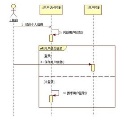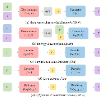Mainstream solutions to Sequential Recommendation (SR) represent items with fixed vectors. These vectors have limited capability in capturing items' latent aspects and users' diverse preferences. As a new generative paradigm, Diffusion models have achieved excellent performance in areas like computer vision and natural language processing. To our understanding, its unique merit in representation generation well fits the problem setting of sequential recommendation. In this paper, we make the very first attempt to adapt Diffusion model to SR and propose DiffuRec, for item representation construction and uncertainty injection. Rather than modeling item representations as fixed vectors, we represent them as distributions in DiffuRec, which reflect user's multiple interests and item's various aspects adaptively. In diffusion phase, DiffuRec corrupts the target item embedding into a Gaussian distribution via noise adding, which is further applied for sequential item distribution representation generation and uncertainty injection. Afterwards, the item representation is fed into an Approximator for target item representation reconstruction. In reversion phase, based on user's historical interaction behaviors, we reverse a Gaussian noise into the target item representation, then apply rounding operation for target item prediction. Experiments over four datasets show that DiffuRec outperforms strong baselines by a large margin.
翻译:主流的序列推荐系统采用固定向量表示物品,这些向量在捕捉物品的潜在特征和用户的多样化偏好方面有限。作为新的生成范式,扩散模型在计算机视觉和自然语言处理等领域已经取得了极好的性能。据我们所知,它在表征生成方面的优势很好地符合序列推荐的问题设置。本文首次尝试将扩散模型应用于序列推荐,并提出了DiffuRec,用于物品表示构建和不确定性注入。DiffuRec不同于在传统SR中将物品表示为固定向量,而是采用分布表示物品的表示,这反映了用户的多重兴趣和物品的各种角度自适应性。在扩散阶段,DiffuRec通过添加噪声将目标物品嵌入到高斯分布中,进而用于生成序列物品分布表示和注入不确定性。之后,物品表示被馈送到Approximator中,用于目标物品表示的重构。在反演阶段,基于用户的历史交互行为,我们将高斯噪声反演为目标物品表示,然后通过舍入操作进行目标物品预测。在四个数据集上的实验表明,DiffuRec的性能大幅优于强基准线。



